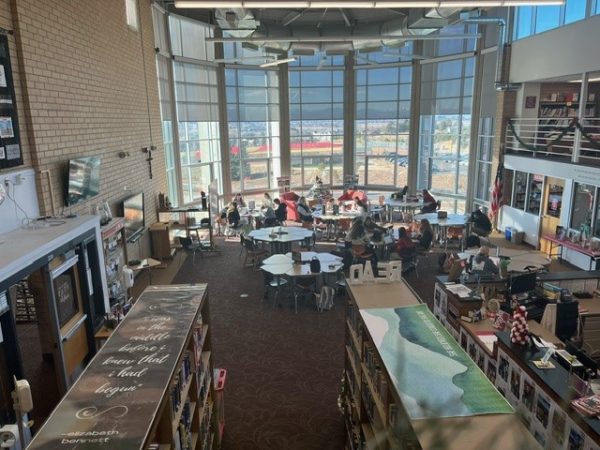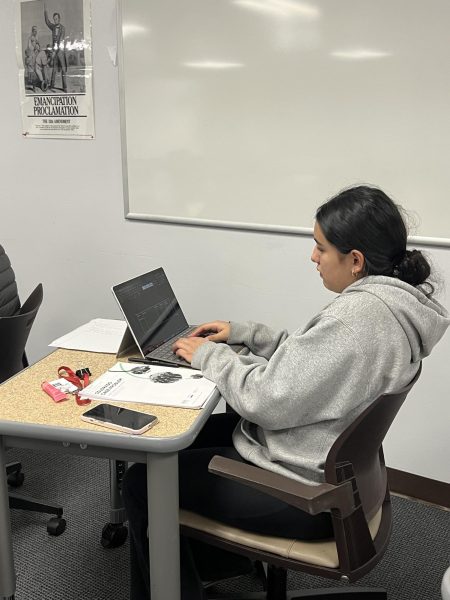Teens and Tech: learning takes on new digital look
How Technology Affects Kids in the 21st Century
“I’ll Facebook message you. Follow me on Twitter. Just email me the link. Can you post that on Instagram?”
All these phrases didn’t even exist a mere twenty years ago. Now they’re normal conversations between teens at school, at home, pretty much anywhere.
The technological revolution that is going on in the world right now is moving faster than it ever has, thanks to the high speed Internet and the 4G service. Teenagers today are being swept away into incredibly fast-paced lives, but what effect is it having on them? Because technology envelops all parts of civilization in the United States, it is necessary to look at all the places that technology has spread to, and analyze them to see what they do to kids these days.
Technology in Classrooms
Technology has spread to every facet of life, and the school is no exception. Technology in the classrooms has exploded onto the scene recently, and has become increasingly easier and cheaper with the invention of handheld devices like the iPad and other similar tablets.
This new style of teaching and learning can be intimidating to some people who fear it might change school too much. It is actually yet to be determined how technology affects students in the long run, because it simply hasn’t been around long enough to collect any usable data on the subject.
The benefit to having this technology accessible to students is the instant availability of the information. With all the information gathered in one central location, the Internet, everything can be accessed with the touch of a button.
Marty Twarogowski, Director of Information Services at Graland Country Day School, thinks that this is one of the best things about having tablets in the classroom. “If you don’t know what a word means you can click on it and it will define it for you. You don’t have to put down the book, go to a dictionary, look up a word which you probably won’t do,” Twarogowski said.
This instant access can also be a disadvantage as well. Since most schools with a one to one program give their kids the tablets, they always have them. This could potentially be a big distraction for many students, what with all the apps and games that are available on app stores.
Another concern for parents is that their kids will be getting into dangerous or inappropriate situations while online. Twarogowski says that there are many parents in their community that have expressed concern about this to him and his staff.
There are a lot of scary things for parents to be concerned about, but Twarogowski says that these can be avoided with the right training, by making the kids good digital citizens.
“Digital citizenship is part web literacy, like what sites are credible. We also like to focus on the do’s and don’ts of the internet. Understanding what it means to post a picture of yourself or someone else online and the repercussions of those actions,” he said.
These skills are taught to kids at Graland and other schools with similar programs around second or third grade, so they can really understand it early. If they can learn to be responsible digital citizens while online, Twarogowski believes this will address the parents concerns of their child being irresponsible online. One of the biggest issues regarding technology in classrooms is the changing teaching style. But the goal of technology is not to replace teachers as educators, just to change their role.
“What we want to do is not necessarily substitute what the teachers are doing but actually augment it” Twarogowski said. “Teachers are becoming more coaches than teachers.”
The teachers are going to become less knowledge keepers, and more guides to the student’s learning. They will obviously still have to know things but more emphasis will be put on the student to do the research on the internet instead of learning it in a more traditional way.
This change will need a good set of guidelines for it to be successful, because there are many things that can go wrong with it if not properly executed.
Bernard John Poole, a professor of Educational and Instructional Technology at Pittsburgh lays out the basics in his Ten Pillars of Successful Technology Integration in K-12 Schools.
1. Leadership must provide active and committed support
2. Selling is better than telling; everyone needs to buy into the change that technology brings
3. Invest in, and train, a core team of teacher-technologists
4. Recognize that technological change is fast; keeping up to date is challenging and essential
5. All teachers must receive ongoing training
6. All teachers must receive technical support, ideally on-site and on demand
7. Use it or lose it; teachers must plan on frequently integrating technology into lesson plans in order to maintain currency and fluency in its application
8. Parents and students must be actively involved in the evolutionary process
9. There must be planned and systematic financial investment in technology-integrated teaching and learning
10. Recognize that technology is for all, and involves all, in the process of lifelong learning

A big theme in Poole’s Ten Pillars is that both the teachers and the administration has to be fully on board with this switch, and actually take advantage of the benefits. Teachers can’t be stubborn with this, they have to accept that this is the way of the future and go with it. If these can all be accomplished, Poole believes this will be a good base for all schools trying to move into the 21st century.
Health Effects of Technology
As Technology rapidly advances to make people’s lives easier, studies on its effects on the human body and behavior are out of date. Although the study of these behavioral disorders are lacking, these problems are quickly gaining the attention of medical experts.
In a May article from the Huffington Post titled “The Impact of Technology on the Developing Child” a Pediatric Occupational Therapist, Chris Rowan writes “The impact of rapidly advancing technology on the developing child has seen an increase of physical, psychological and behavior disorders that the health and education systems are just beginning to detect, much less understand.“
Although these disorders are alarming, many health physicians like Rowan are mainly concerned that both kids and adults aren’t getting outside enough.
Rowan believes “Four critical factors necessary to achieve healthy child development are movement, touch, human connection, and exposure to nature.”
While kids are not getting outside enough, studies show that adults are also spending more time on social networking sites and are developing bad habits that affect everything from their marriage to their work.
Human Kinetics is a business that specializes in providing quality information on physical activity and health. Their book “Dimensions of Leisure for Life” discuses the positive and negative effects of technology on people.
“Some assert that these Web sites contributed to cheating on significant others, often leading to divorce. People have been fired from their jobs or put under pressure because they use these sites at work or because something is posted on a site that undermined the person’s professional standing,” the book states.
Many medical experts think these deteriorated behaviors are due to regression of basic behaviors such as patience. In children these behaviors in some cases are not being developed.
“We see a lot of kids whose attention is affected by the technology they use and their ability to interact and have conversations with others is severely negatively affected by the technology” Dr. Jordan, a Pediatric doctor for Cornerstone Pediatrics said.
While the future for child and adult development looks bleak, there is a simple solution to the problem of technology overuse. Put the electronics away and go outside.
“People should interact with technology three to two hours at max per day. It is important to find time to put the technology devices away and interact with real people and friend,” Dr. Jordan said.

Although the solution to the problem of technology overuse is simple, it isn’t appealing to many people.
Dimensions of Leisure for Life discusses this issue.
“Overcoming a sense of isolation is one of the greatest features of online communities and virtual worlds. Someone might feel like an outcast in her own community or family but might find someone online with similar hobbies, pursuits, and interests. However, simply sharing common interests and pursuits with people through technology does not necessarily have a positive impact on social skills and social development,” “Dimensions of Leisure for Life” states.
As technology progresses, some companies have tried to combine healthy activity with technology usage.
“Although there may be ways to integrate healthy activity with technology there is no substitute to going outside,” Dr. Jordan said.
Overall, most medical experts agree that going outside is the best remedy to the issues created by technology. These physicians are not condemning technology, they just stress the importance of responsibility when using it.
Technology and Social Effects
Technology today has affected so many social aspects of everyday life, both positively and negatively. In the classroom, gadgets such as tablets and smartphones have proven to be helpful, but they can also serve as a distraction.
According to an article from the Pew Research Center, 78 percent of teens now have a cell phone, and almost half (47 percent) of them own smartphones. That translates into 37 percent of all teens who have smartphones, up from just 23 percent in 2011.
Mr. Jason Beyer is a theology teacher and head of the iPad program at Regis Jesuit High School in Aurora, Colorado.
“With Facebook, with Twitter, and with the advance of technology we can activate responses from a global perspective and on a global scale very quickly, so it can be very useful for the betterment of other people,” Beyer said.
However, according to Pew Research Center, with technology advancing so fast there is a 66 percent rise in Obsessive Compulsive Disorder (OCD) and Attention Deficit Hyperactivity Disorder (ADHD).
“Do we use technology to insulate us? Do we use it and become overwhelmed by the amount of information? or Do we use it to really become educated? this is a huge challenge,” Beyer said.
With younger people, video games can be a big part of their everyday lives. Poor social skills are some of the outcomes known to resolve from video game use. However they also are known to build imagination skills and to serve as a stress reliever, stated an excerpt from Human Kinetics.
With all the gadgets and electronics available to us today, television has mixed reviews of whether it is good or bad. In the same excerpts from Human Kinetics, they observe that television is a passive medium, therefore it has the potential to benefit us but it provides little opportunity for meaningful interaction.
What we see on the television is what can affect us the most. With all the violence, gore, and inappropriate behavior we see on the television, it almost encourages us to mimic what we see. These type of actions cause us to lack integrity and conduct ourselves in false fashions.
“Technology is like a scalpel. It can be used to heal things or it can be used to harm things. It all depends on the person using it,” Beyer said.
Social development can also rely heavily on knowing the things that are going on around you. Without knowing current activities of the world around you, a person could become totally oblivious to their surroundings.
“The good side is, you can hear a story that is affecting somebody for the detriment of their well being and their humanity from across the world within fifteen minutes. On the down side, I can also insulate, I cannot go to different news sources or websites that don’t support my political persuasion or what have you,” Beyer said.
Obviously, technology has the capability to either harm or enhance the social life and social skills of people, but it is in the hands of the user based on how it will affect them.
Technology has become so ingrained in society that it is almost impossible to imagine life without it. There is no stopping technology, especially with all the benefits that it provides not only for use in school but for recreation as well.
The key to surviving this technological revolution is being smart about it. With Bernard Poole’s Ten Pillars, teachers and administrators can have a guide to using technology in their classrooms.
And if kids and their parents can become aware of the social and health effects of this technology and limit the screen time, these disadvantages can become less prominent, and people can move more seamlessly into this new age of tech.







